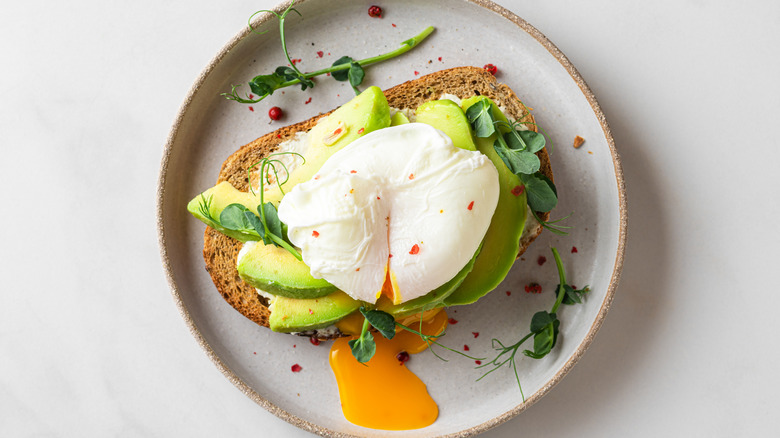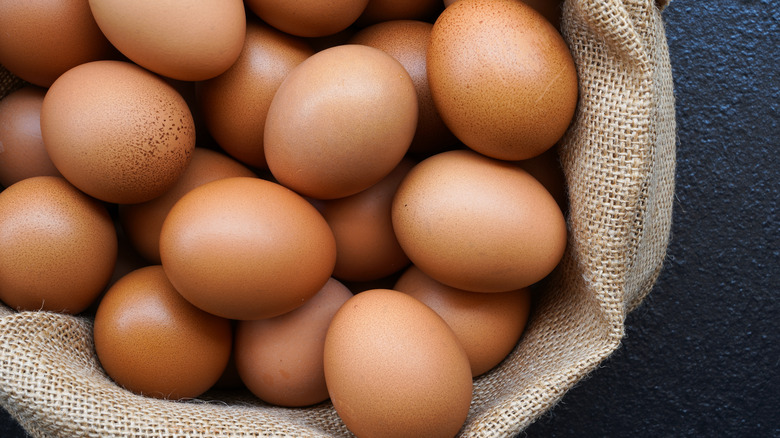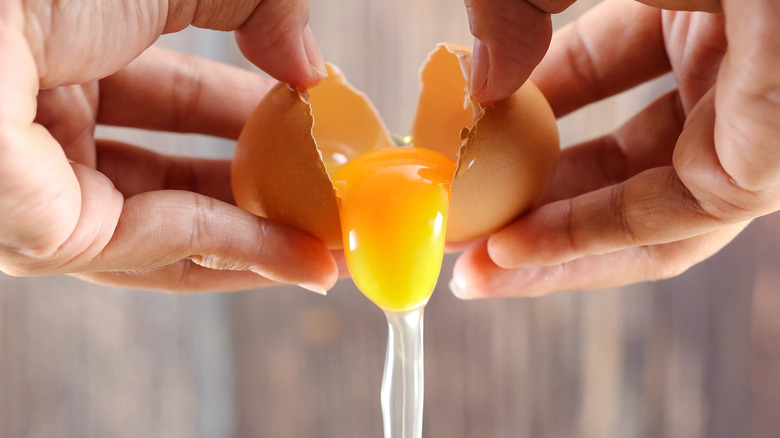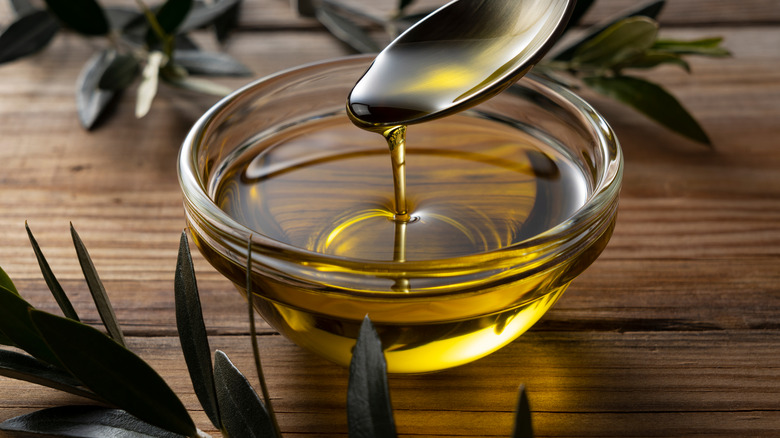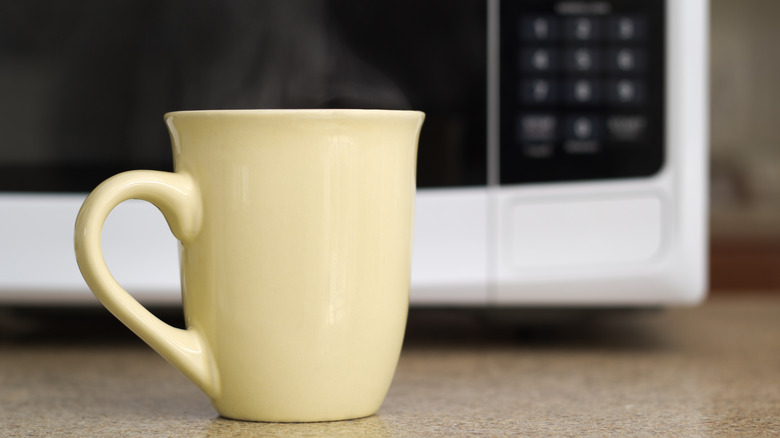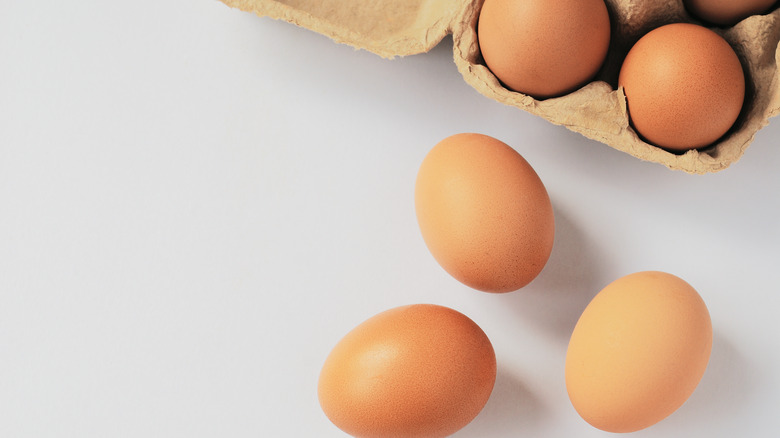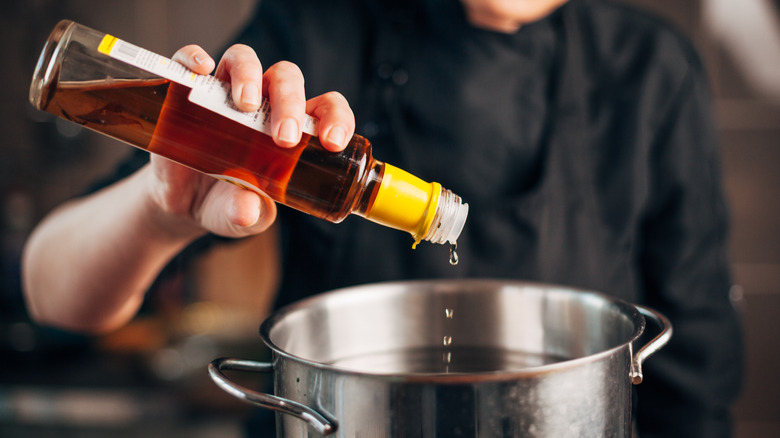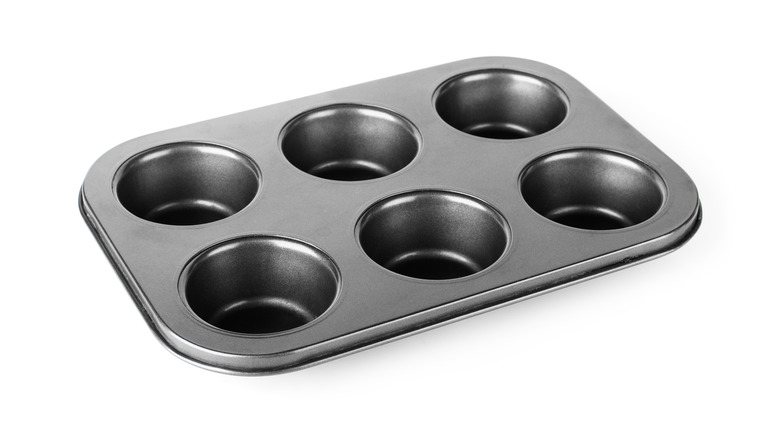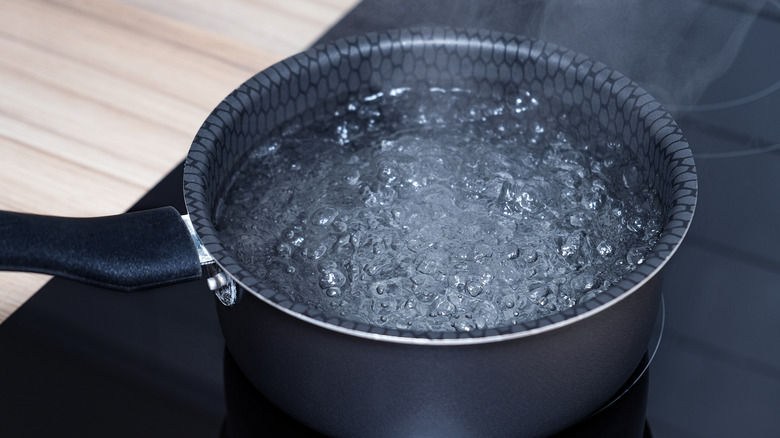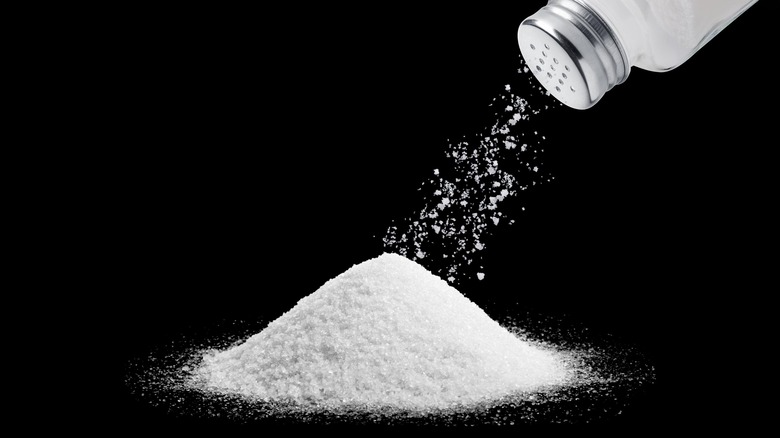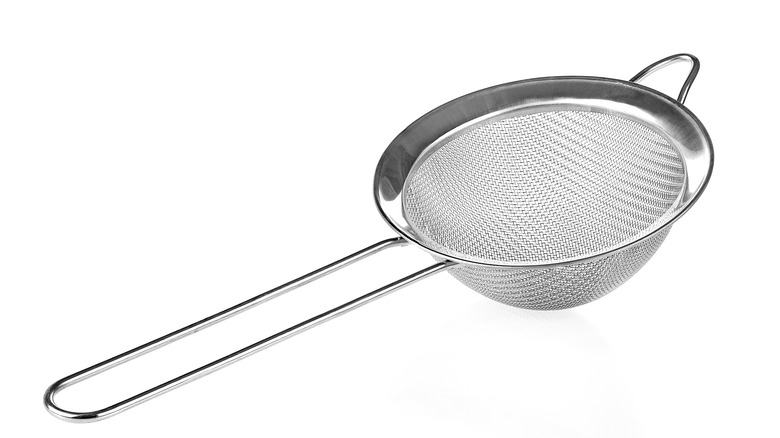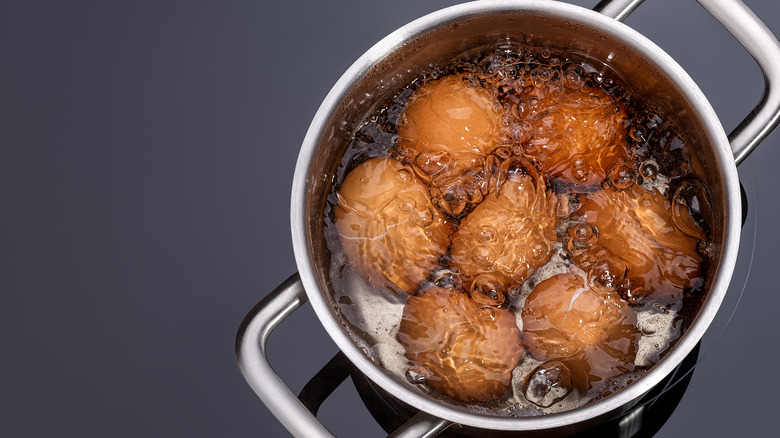The 11 Biggest Mistakes Everyone Makes When Poaching Eggs
If you're a big brunch person, you're probably into poached eggs. And we get it. We love them too. That perfectly shaped egg oozes a warm, smooth yolk with the touch of your fork. It's the ideal egg to place atop your toast or simply eat on its own. No matter how you like to enjoy them, one thing is for sure: You have to cook them right. And cooking them right can take some time and effort to get the hang of.
The poaching process can be fickle. While it may seem easy to crack an egg and drop it in some water, there are many mistakes one can make along the way. It also depends on what you use to cook them, such as using only water or opting for other ingredients like vinegar or oil. Whatever you do, you don't want your poached egg coming out overcooked or broken, and we're here to help make sure that doesn't happen. Here are some of the biggest mistakes people make when poaching eggs, and how you can avoid them.
Not using fresh eggs
If you poach eggs at home and they come out rubbery or broken, chances are it's because the eggs used aren't all that fresh. It's extremely important to stick with the freshest eggs possible when poaching because they are much stronger than eggs that are past their prime. They will be able to withstand the cooking process while keeping the shape you want them. Even an egg that is a few days past its freshest can result in torn egg whites and trouble keeping any kind of shape.
Looking at the expiration date on the egg carton will surely help you decide whether they should be used or not, but there's also a water trick you can try to see which eggs are best for poaching. Simply drop your eggs in water —if they're standing vertically or drifting toward the top, you might want to keep them for when you are frying an egg and don't need any real shape. For poaching, look for eggs that sink to the bottom and sit horizontally. These are the eggs that are super fresh and won't break when using them.
Cracking eggs directly into the water
We know poaching an egg at home is not always an easy task. There is a lot that can go wrong. One small mistake can lead to a huge disaster and make you wish you'd scrambled your eggs rather than trying to poach them. A big poaching fail is cracking the eggs directly into the water during the poaching process. This will only lead to your eggs turning out watery and runny, according to MyRecipes, which is not what you want with a poached egg.
The next time you try poaching, avoid that common egg mistake and instead crack your eggs into a bowl while the water simmers on the stovetop. Then, turn the heat down on the stove so the water is just simmering. Take a spoon and swirl it around in the water so it resembles a whirlpool. Only then is when you should drop your egg in.
Not cooking eggs in olive oil
If you aren't already cooking your poached eggs in olive oil, now is the time to try it. It's not the conventional way to poach an egg, but it is worth giving a shot since the end result is pure perfection. Instead of heating water on your stovetop, use a quarter cup of olive oil. Heat the oil on medium, crack your egg, and drop it in the pan. Be sure to move the egg around in the pan so it doesn't burn. You're not after fried eggs after all. You also want to make sure you keep the yolk creamy and don't overcook it. Once the egg whites are cooked all the way, you'll know it's time to remove the egg from the heat.
The end result is a deliciously poached egg cooked to perfection. While they may look a little different than when poached in water, appearance won't change how much you enjoy eating them. Trust us.
Using a mug to poach an egg in the microwave
Poaching an egg in the microwave might seem like the easiest option. Does it get any simpler than dropping your egg into a mug with water and cooking on high for less than a minute? Probably not, but you need to be careful, because this can also be one of the most dangerous ways to go about poaching your egg. When cooked in a mug in the microwave, the egg can actually explode, and hot water can spray everywhere, including on you.
For safety's sake, skip the mug completely and use a heat-proof soup bowl instead. You'll also want to microwave the water first on its own before adding the egg. Once you strain the egg and drop it into the bowl, allow it to sit outside of the microwave so the whites turn opaque. Then you can cover the bowl (with the egg in it) and pop it back into the microwave for another minute. Flip the egg over and cook for about 10 seconds before removing it with a spoon.
Not submerging egg under water
We know the microwave makes tasks like poaching much simpler, and everyone can use that kind of efficiency at breakfast time. After all, the quicker you cook your breakfast, the quicker you can eat it. But there's more to it than just using a heat-safe bowl. In order to make the perfect poached egg in a microwave, you want to make sure the water level is just right.
Start by filling your bowl with about a half cup of water. You'll then crack the egg in the water and ensure that it is completely submerged. Cover the bowl and cook on high for about a minute before removing the egg from the water with a slotted spoon. Just remember, each microwave is different in terms of how fast it cooks, so it may take some trial and error to find the perfect temperature for the poached eggs of your choice.
Not adding vinegar or lemon juice
Mastering the poached egg at home can seem a bit intimidating, and for good reason. As we've already seen, there are so many methods and tricks to use when poaching an egg. Whether it's on the stove or in the microwave, in water or in oil — there's a lot to remember. But if you're going to do the job right, there are a couple more ingredients you should consider: vinegar and lemon juice.
Some chefs swear by adding vinegar or lemon juice to the poaching water, but pouring the acid in with the egg works to a similar effect. Crack an egg into a cup and place a teaspoon of vinegar or lemon juice in the mix. This will actually help the egg will hold its shape better than on its own. Once the pan comes to a light (read: not rolling) boil, the egg is dropped in and the heat is then turned off. In about 5 minutes, you will have the perfectly poached egg.
Not using a muffin tray when poaching in the oven
We're big fans of the muffin tin in our kitchen, and not just for making muffins. We use it for all kinds of things, including as a condiment tray and for making our own tortilla bowls. But a muffin tin can also help make poaching eggs in the oven much easier.
Using a muffin tray allows you to poach eggs in bulk, which is ideal when you're having people over for brunch at your place. It also helps free up time as you're not stuck standing over the stovetop swirling your eggs. To try this method, grease up your muffin tray before adding roughly a centimeter of water into each section and cracking the eggs into them. Cook your eggs at 350 degrees for up to 15 minutes, checking in the first 5 minutes to make sure they are cooking correctly.
Not stirring the water on the stovetop
Celebrity chefs love trying new things when it comes to cooking. Poaching an egg is no different. Many chefs have their own methods of perfecting this type of egg, including Geoffrey Zakarian. He knows a thing or two about making some solid eggs — after all, they are his favorite food (or he says on Instagram). So, naturally, he has his own unique technique to poach an egg.
He starts by cracking an egg and dropping it into a ramekin. Then, he salts his water before adding a touch of red wine vinegar. That's all pretty standard as we see it. But in Zakarian's trick to perfectly poached eggs, he then stirs the water to create a whirlpool effect before dropping the eggs in. It's a common technique endorsed by other celebrity chefs, and it can make all the difference in shaping your poached eggs. After about 3 minutes, Zakarian scoops the eggs out from the water with a slotted spoon, and voila! A perfect poached egg for all to enjoy.
Using salt
Salt and eggs pretty much go hand-in-hand. We know you're reaching for the salt shaker to sprinkle atop your eggs once they are cooked and ready to eat. And boiling water and salt also go together in most cases, right? Of course, especially when making pasta. But if you're using salt in your water when making poached eggs, you'll probably want to stop that right now.
Here's the thing: Salting your water can ruin your poached egg. Instead of producing a gorgeous, shapely egg white, you'll likely have one that comes out broken. No one wants a torn-up egg white to place atop their avocado toast. Without salting the water, there's a much better chance you'll walk away with a perfectly formed egg white and a creamy yolk. That's not to say you shouldn't use salt at all with poached eggs. Just save the sprinkle until after they're cooked.
Not using a strainer
Ah, the kitchen strainer. This small tool comes in handy when you're looking to separate liquids from solids. It can be a great addition to your poaching process, too, according to Serious Eats. Crack an egg into a mesh strainer and let the liquid part of the egg white drain by swirling it around. Once the egg is strained enough, you can drop it into simmering water and get to cooking.
By straining your egg before cooking, you're removing the thin, stringy part of the egg white that can lead to unsightly, misshapen eggs. Here's another pro tip: Add your egg to the water while it's still in the strainer, per Serious Eats. Doing this can allow you to shape the egg by using the strainer's rounded edge. You'll then release the egg from the strainer once the egg turns white and you're left with a poached egg as good as what you've had at restaurants.
You're poaching eggs in boiling water
Boiling your eggs works great when you want a hard cooked egg. But if you're looking for perfectly soft eggs, you'll want to stop poaching eggs in boiling water. Here's why: Boiling water has a way of cooking your egg too fast which can lead to possibly breaking the egg white. As a result, you'll find your egg whites are more wispy rather than perfectly formed.
To create the perfect poached egg, you'll first need to crack it and then submerge it in hot water. But instead of placing them in boiling water, you'll want to use something called a "rolling simmer" so your eggs aren't cooking up too fast. When heating your water be sure to watch for small bubbles on the surface and not rolling bubbles that keep breaking the water's surface. This will ensure your water is at the right temperature so your eggs are cooking but won't be breaking in the process. As Cook's Illustrated writes, the difference in temperature between a rolling simmer or boil can be up to 32 F — the difference between an overcooked egg and a perfectly silken poached one.
